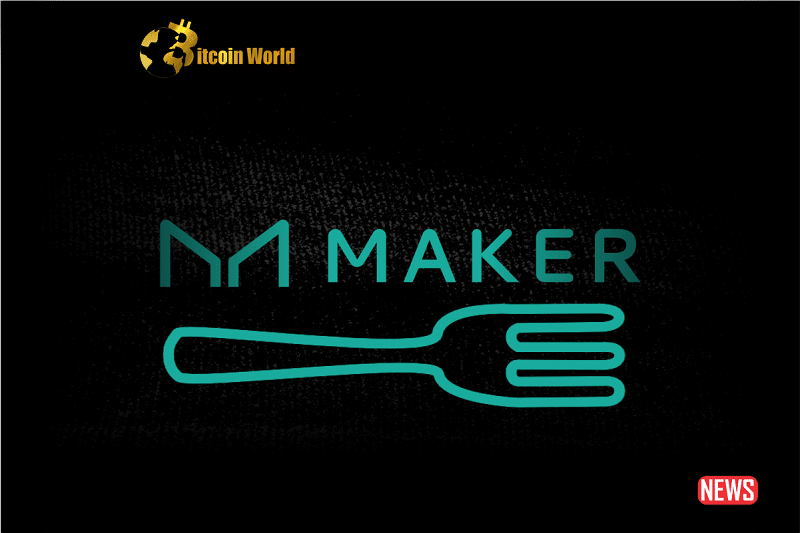Hold onto your hats, crypto enthusiasts! The DeFi world is buzzing with a plot twist straight out of a thriller. Imagine the biggest player in decentralized lending, MakerDAO, contemplating a move that could reshape the landscape. We’re talking about a potential fork to Solana, a decision that’s not just turning heads but also sparking some serious debate, and even a notable reaction from Ethereum’s very own founder, Vitalik Buterin.
The Shockwave: MakerDAO Eyes Solana
In a move that sent ripples through the crypto community, Rune Christensen, the co-founder of MakerDAO, dropped a bombshell: a proposal to fork the Solana codebase for MakerDAO’s future appchain migration. Why Solana? Christensen highlighted several compelling reasons:
- Scalability: Solana is known for its high throughput and ability to handle a large number of transactions quickly.
- Multiple Security Clients: This offers enhanced resilience and security for the network.
- Proven Track Record of Appchains: Solana has already demonstrated success in hosting dedicated application-specific chains.
This consideration comes as part of MakerDAO’s ambitious “Endgame” overhaul, a plan to create a dedicated network, dubbed “NewChain,” for the protocol. Think of it as moving house to a brand new, custom-built mansion designed to handle all of MakerDAO’s specific needs. This new network would feature updated MKR and DAI tokens, specialized subDAOs, and a refined governance structure.
But Why the Big Move? Tackling the Technical Debt
Eight years in the crypto space is an eternity. MakerDAO, while a pioneer, has accumulated what Christensen refers to as “technical baggage.” The “NewChain” initiative aims to address this by essentially rebuilding each protocol component from the ground up, perfectly aligned with the final “Endgame” vision. This is about future-proofing and ensuring MakerDAO can continue to innovate and scale.
Vitalik’s Verdict: A Swift and Decisive Response
Enter Vitalik Buterin. News of MakerDAO’s potential Solana move didn’t sit well with the Ethereum co-founder. In a move that spoke volumes, Buterin swiftly sold his 500 MKR holdings for 353 ETH, a transaction worth around $580,000. This action caused a ripple effect, contributing to a 5.6% dip in the price of the MKR governance token from its recent high. It was a clear statement of his disapproval.
What’s Buterin’s Play? Supporting the Competition
The drama didn’t stop there. Buterin then appeared on Reflexer’s Discord server. Reflexer is the team behind RAI, an ETH-backed stablecoin that operates without a traditional peg, making it a direct competitor to MakerDAO’s DAI. Buterin urged Reflexer to adopt minority liquid staking tokens (LSTs) to strengthen its position in the Ethereum stablecoin market. This seems like a strategic maneuver to bolster a competitor as MakerDAO contemplates its departure.
The Centralization Concerns: Lido’s Dominance
Buterin’s call for supporting non-dominant LSTs highlights a growing concern within the Ethereum ecosystem: centralization. Lido currently controls a significant portion of the liquid staking market, raising questions about the potential risks associated with such concentrated power. Buterin’s stance encourages a more distributed and resilient staking landscape.
Solana vs. Cosmos: The Contenders for MakerDAO’s Future
While Solana seems to be the frontrunner, Christensen did acknowledge Cosmos as another potential option. However, he cited concerns about its efficiency compared to Solana. This isn’t entirely surprising, given MakerDAO’s focus on scalability and performance for its future appchain.
Appchains: The Future of Demanding Applications?
MakerDAO’s exploration of appchains aligns with a growing trend in the crypto space. Appchains, or application-specific blockchains, offer a dedicated environment for applications with demanding requirements, such as high transaction speeds and throughput. Recent examples include:
- dYdX: The decentralized exchange community voted to migrate to a Cosmos-based Layer 1.
- Aave’s Lens Protocol: This decentralized social media platform utilizes Momoka, an Ethereum-backed Layer 3 appchain.
The Timeline: Patience is Key
For those eagerly anticipating the launch of “NewChain,” patience will be required. Christensen estimates that the appchain migration is at least three years away. This highlights the complexity and scale of the undertaking.
What are the Potential Benefits and Challenges?
Let’s break down the potential upsides and downsides of MakerDAO’s proposed move:
| Benefits | Challenges |
|---|---|
| Improved scalability and performance | Potential fragmentation of liquidity |
| Reduced reliance on Ethereum’s gas fees | Increased complexity in managing a separate chain |
| Greater control over the network’s architecture | Security considerations of a new chain |
| Opportunity to rebuild and optimize the protocol | Community division and uncertainty |
Actionable Insights: What Does This Mean for You?
- Stay Informed: Keep a close eye on developments within the MakerDAO community and the broader DeFi space.
- Consider the Implications: Think about how this potential migration could impact the value of MKR and DAI, as well as the competitive landscape of stablecoins.
- Diversify Your Portfolio: The current uncertainty highlights the importance of diversifying your crypto holdings.
The Saga Continues…
The future of MakerDAO’s migration remains uncertain. With strong opinions, influential players, and significant stakes involved, this saga is far from over. The cryptocurrency community is watching with bated breath as this drama unfolds. Will MakerDAO proceed with its Solana fork? How will Ethereum adapt to this potential shift? Only time will tell. Stay tuned for more updates as this captivating story develops!
Disclaimer: The information provided is not trading advice, Bitcoinworld.co.in holds no liability for any investments made based on the information provided on this page. We strongly recommend independent research and/or consultation with a qualified professional before making any investment decisions.


